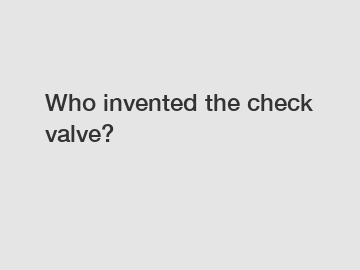Who invented the check valve?
Who Invented the Check Valve?
A check valve is a small but essential device that allows flow in only one direction in a piping system. It is designed to prevent backflow and protect equipment, ensuring uninterrupted and safe operation. You may wonder who the brilliant mind was behind the invention of this simple yet crucial component. In this article, we will delve into the origins of the check valve and explore its significance in various industries.
Ancient Roots and Early Developments.

The history of the check valve can be traced back to ancient times, where it was initially used in water distribution systems. The ancient Egyptians used simple check valve systems to control the flow of water in their irrigation systems. These early valves were made of wood and relied on gravity and buoyancy principles to operate effectively.
During the Roman Empire, advancements were made in valve technology. The Romans incorporated check valves made of bronze and lead into their aqueducts and water distribution systems. These valves provided a more efficient method of controlling water flow and preventing backflow.
Industrial Revolution and Modernization.
However, it was during the Industrial Revolution in the 18th century when significant advancements took place in check valve technology. The need for reliable valves became more pressing as steam power began to dominate industrial machinery. Thomas Newcomen, an English inventor, is often credited with the invention of the check valve during this period. Newcomen's valve design was used in his atmospheric steam engine, which required a check valve to control the flow of steam.
In the 19th century, Charles Goodyear, an American inventor and engineer, contributed to the development of the check valve by inventing vulcanized rubber. This invention allowed for the production of valve discs that were resilient and could effectively seal against the valve seat. Goodyear's contribution revolutionized the durability and effectiveness of check valves.
Applications and Importance.
Check valves are now widely used in various industries, including oil and gas, water treatment, chemical processing, and HVAC systems, among others. In these industries, the check valve plays a crucial role in preventing fluid backflow, protecting equipment from damage, and ensuring the safety of personnel.
In the oil and gas industry, check valves are essential for maintaining pressure and preventing the flow of fluids in the wrong direction. They are commonly used in pipelines, wellheads, and drilling equipment. In water treatment plants, check valves are used to prevent the contamination of clean water from backflow. These valves are also employed in chemical processing plants to control the flow of hazardous substances and maintain the integrity of the system.
Closing Thoughts.
The check valve is a simple yet ingenious invention that has played a vital role in various industries for centuries. Its origins can be traced back to ancient civilizations, but it was during the Industrial Revolution that significant advancements were made. Today, check valves are crucial for ensuring the safe and efficient operation of equipment and systems in a wide range of industries.
If you have any questions about check valves or need assistance in selecting the right valve for your specific application, please do not hesitate to contact us. We have a team of experts who will be happy to help.
For more titanium flange gr2, nipolet flange, monolithic insulating jointinformation, please contact us. We will provide professional answers.

Comments
0